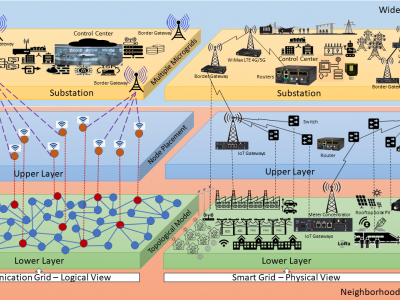Wireless Networking

Extended reality (XR) head-mounted displays (HMDs) are increasingly starting to rely on wireless task
offloading in a bid to allow unobstructed XR user movement, while still rendering high-resolution video on
a remote processing node. An example is the Oculus (Meta) Quest 2. However, congestion and reliability
issues associated with the wireless network can cause high latency and an overall low quality of service (QoS).
Therefore, understanding XR user mobility is of vital importance for supporting XR applications in future
wireless networks.
- Categories:
 183 Views
183 Views
As communications service providers ponder ways to cater to the diverse traffic requirements of mobile applications that range from the classic telephony to modern augmented reality (AR)-related use cases, the traditional quality of service (QoS)-based radio resource management (RRM) techniques for RAN slicing that are agnostic to the intrinsic workings of applications can result in a poor quality of experience (QoE) for the end-user. We argue that in addition to QoS, RAN slicing strategies should also consider QoE for efficient resource utilization.
- Categories:
 348 Views
348 ViewsThe increasing availability of multimodal data holds many promises for developments in millimeter-wave (mmWave) multiple-antenna systems by harnessing the potential for enhanced situational awareness. Specifically, inclusion of non-RF modalities to complement RF-only data in communications-related decisions like beam selection may speed up decision making in situations where an exhaustive search, spanning all candidate options, is required by the standard. However, to accelerate research in this topic, there is a need to collect real-world datasets in a principled manner.
- Categories:
 435 Views
435 Views
Normal
0
false
false
false
EN-US
JA
X-NONE
- Categories:
 102 Views
102 Views
We created a 5G dataset by measuring 5G traffic directly from a major mobile operator in South Korea. The model name of the mobile terminal used for traffic measurement is the Samsung Galaxy A90 5G, equipped with a Qualcomm Snapdragon X50 5G modem. We installed PCAPdroid, a packet sniffer software, on the terminal via Google Play. Traffic was measured sequentially per application on two stationary terminals (only one terminal is used for noninteractive services) with no background traffic.
- Categories:
 7446 Views
7446 Views
A multi-scale attention based channel estimation framework is proposed for reconfigurable intelligent surface (RIS) aided massive multiple-input multiple-output systems, in which both hardware imperfections and time-varying characteristics of cascaded channel are investigated. By exploiting the spatial correlations of different scales in the RIS reflection element domain, we construct a Laplacian pyramid attention network (LPAN) to realize the high-dimensional cascaded channel reconstruction with limited pilot overhead.
- Categories:
 261 Views
261 Views
Over 10% of the world's population now suffers from chronic kidney disease (CKD), and millions die yearly. To extend the lives of those suffering and lower the cost of therapy, CKD should be detected early. Building such a multimedia-driven model is necessary to detect the illness effectively and accurately before it worsens the situation. It is challenging for doctors to identify the various conditions connected to CKD early to prevent the condition. For CKD early detection and prediction, this study introduces a novel hybrid deep learning network model (HDLNet).
- Categories:
 577 Views
577 ViewsNeighbourhood area networks (NANs) lay the foundation for robust communication in smart grids to support stable and secure end-user connectivity with substations. Firstly, the current solutions are unrealistic to meet the time-bound requirements for smart grid applications with large number of intermediate node connectivity in NANs. Secondly, the existing Low-power Wireless Personal Area Network (LoWPAN) do not scale up to thousand nodes while meeting the latency requirement of delay-critical smart grid applications.
- Categories:
 39 Views
39 ViewsThis paper investigated how to increase the number of connections among users in hierarchical non-terrestrial networks (HNTNs) assisted disaster relief service (DRS). We aim to maximize the number of satisfactory connections (NSCs) by optimizing the unmanned aerial vehicles (UAV) radio resources, computing resources, and trajectory at each time slot. In particular, the UAVs are exploited as aerial base stations (ABSs) to provide a link for the reduced capability (RedCap) user equipment (UE) based on power domain non-orthogonal multiple access (PD-NOMA).
- Categories:
 608 Views
608 Views
The maximum flow problem based on contact graph in DTN is very important for routing and data planning. Common topological graphs with non-sequential changes include Dinic, ISAP and other deterministic algorithms for solving the maximum flow between two nodes. But these algorithms cannot be directly applied to topological networks with time series changes. At present, Iosifidis.G has given a solution to this problem based on the time expansion graph, but his method requires high storage space, and the increase in the number of nodes means increasing high time complexity accordingly.
- Categories:
 104 Views
104 Views